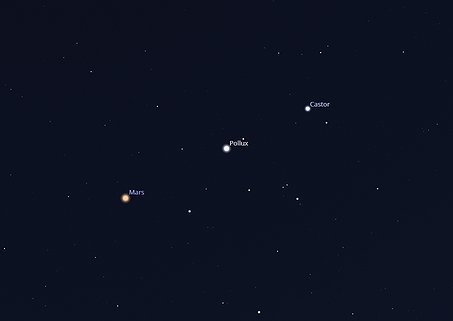Best night sky events for April
April promises an exciting display of celestial events for astronomy enthusiasts. This month will give us an engaging list of planetary and lunar alignments, a meteor shower, and moon phases, including the Pink Moon.
April 1 — The moon and the Pleiades (M45)
Timing is everything when everything is moving. At 1 p.m., the moon was right in the middle of the Pleiades star cluster, but by the time we can see it, at 8 p.m., the moon will have moved 7 degrees away from the Pleiades in just eight hours! After dark, look westward for the Pleiades to the lower right of the moon.
April 4 — First quarter moon
The first quarter moon marks the halfway point between the new moon and the full moon. It appears as a half-illuminated disk, which occurs at 7:15 p.m. and will have the right half visible from the Northern Hemisphere and the left half visible from the Southern Hemisphere and is viewable in the afternoon and evening sky.
April 5 — The moon and Mars conjunction
On this date, the moon will meet up with Mars, passing just over 4 degrees away from the Red Planet. Mars is still bright at magnitude 0.5 and will continue its eastward (leftward) motion.
April 10-12 — Mars makes a straight line with the Gemini twin stars
Mars has moved in the sky to make a straight line with the Gemini twin stars. Look high up after dark to see Mars and the very bright twins, Castor and Pollux. Mars is a little over 5 degrees to the left of the bright 1.2 mag Pollux, and Pollux is just 5 degrees to the left of the slightly dimmer 1.6 mag Castor.
April 12 — Full moon
The moon will be located on the opposite side of the Earth as the sun and its face will be fully illuminated. This phase will occur at 5:22 p.m. The April full moon was known by early Native American tribes as the “Pink Moon” because it marked the appearance of the moss pink, or wild ground phlox, which is one of the first spring flowers. This moon has also been known as the Sprouting Grass Moon, the Growing Moon and the Egg Moon. Many coastal tribes called it the Fish Moon because this was the time that the shad swam upstream to spawn.
April 20 — Last quarter moon
The last quarter moon is the third and final phase of the moon during its monthly cycle. This will occur at 6:35 p.m. The moon once again appears half-illuminated, with the left half visible from the Northern Hemisphere and the right half visible from the Southern Hemisphere. This moon is viewable after midnight and throughout the morning.
April 21 — Mercury reaches greatest angular distance from the sun
The planet Mercury reaches its greatest angular distance from the sun on the West side (as viewed from Earth). This is called its greatest western elongation. This is the time to view Mercury in the morning sky since it will be at its highest point above the Eastern horizon. Look for the planet low in the eastern sky a half hour before sunrise (5:15 a.m.).
April 22-23 — Lyrids meteor shower
The Lyrids is an average meteor shower, producing as many as 20 meteors per hour at its peak. It is produced by dust particles left behind by comet C/1861 G1 (Thatcher), which was discovered in 1861. The shower runs annually from April 16 to 25. It peaks this year on the night of the 22nd and morning of the 23rd. These meteors can sometimes produce bright dust trails that last for several seconds. The light from the thin crescent moon will not be much of a problem, so this should be a relatively good show. The best viewing will be from a dark location after midnight. Meteors will radiate from the constellation Lyra but can appear anywhere in the sky.
April 23 — Venus at greatest brightness
This morning is a great morning to see Venus, as it will be its brightest of any morning in 2025, making it the third brightest object in the sky.
April 27 — New moon
The moon will be located on the same side of the Earth as the sun and thus will not be visible in the night sky. This phase will occur at 3:58 a.m. This is the best time of the month to observe faint objects (magnitude 5+ and dimmer). You should be able to see some of the dimmer galaxies and star clusters because there is no moonlight to interfere.
• • •
John Taylor is an amateur astronomer who lives in Hayden.



